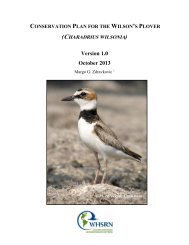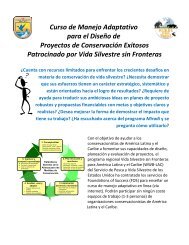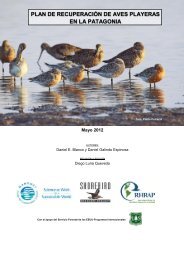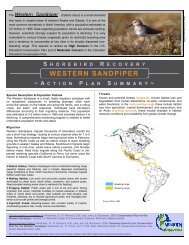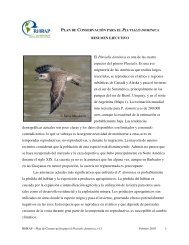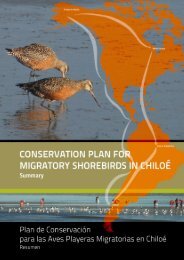Sanderling Plan - Western Hemisphere Shorebird Reserve Network
Sanderling Plan - Western Hemisphere Shorebird Reserve Network
Sanderling Plan - Western Hemisphere Shorebird Reserve Network
You also want an ePaper? Increase the reach of your titles
YUMPU automatically turns print PDFs into web optimized ePapers that Google loves.
of the <strong>Sanderling</strong> as a Species of High Concern (Brown et al. 2001) (Appendix I – III). The<br />
<strong>Sanderling</strong> is listed as a Declining Yellow species on Audubon’s 2007 Watch List.<br />
Regionally, the <strong>Sanderling</strong> appears on a number of special concern lists. It is a Species of<br />
Concern on the Prairie Conservation Action <strong>Plan</strong> of World Wildlife Fund Canada (Dickson and<br />
Duncan 1993). In the Prairie Canada <strong>Shorebird</strong> Conservation <strong>Plan</strong>, <strong>Sanderling</strong> is listed as a<br />
species of High Conservation Concern as a passage migrant (Gratto-Trevor et al. 2001). The<br />
USFWS lists the <strong>Sanderling</strong> as a Bird of Conservation Concern in several Bird Conservation<br />
Regions (BCRs) within the Central Flyway, including: Great Basin (BCR 9), Northern Rockies<br />
(BCR 10), Prairie Potholes (BCR 11), and Badlands and Prairies (BCR 17).<br />
<strong>Sanderling</strong>s are listed as a Species of Conservation Concern on most coastal states’ State<br />
Wildlife Action <strong>Plan</strong>s, for example Florida, North Carolina, Texas, Virginia, and Washington,<br />
among others (State Wildlife Action <strong>Plan</strong>s 2009). State Wildlife Action <strong>Plan</strong>s provide valuable<br />
and current information regarding conservation issues and management needs that relate to<br />
species of concern and their habitats within each state.<br />
POPULATION GOAL(S)<br />
The U.S. <strong>Shorebird</strong> Conservation <strong>Plan</strong> gives a tentative population target of 1,500,000<br />
and to restore <strong>Sanderling</strong> numbers to their 1972 levels (Brown et al. 2001). However, current<br />
population estimates (300,000) have low confidence (i.e., are likely to be in the right order of<br />
magnitude, but are based on broad-scale surveys which do not allow for precise estimates).<br />
Given this uncertainty, it is hard to establish an informed goal at this time, but it may be prudent<br />
to establish one when more information is available. Meanwhile, efforts may be aimed at:<br />
<br />
<br />
<br />
<br />
Improving monitoring schemes so that population estimates are more attainable/precise;<br />
Investigating status of <strong>Sanderling</strong> populations along flyways and on the wintering<br />
grounds;<br />
Halting regional or range-wide declines;<br />
Evaluating and establishing population goals based on carrying capacity (with and<br />
without habitat restoration efforts).<br />
WHSRN – <strong>Sanderling</strong> Conservation <strong>Plan</strong>, February 2010, v1.1 23





